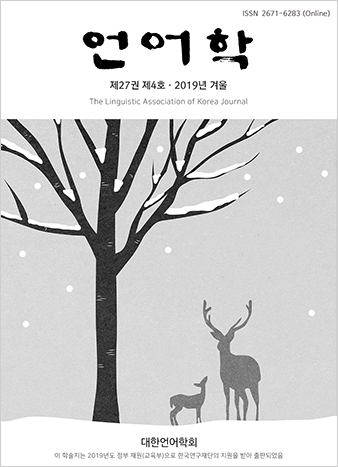대한언어학회 전자저널

-
Anyway as an Unassociative Stance Marker in the American Television Talk Show, Larry King Live
-
Influences of a Native English Teacher and Roles of a Co-teacher on L2 Learners' Learning Styles
-
On the Functions of the Simple Present Tense in The Pilgrim’s Progress
-
Teaching English through Vlogging and In-class Presentation: A Preliminary Comparative Study
27권 4호 (2019년 12월)
- 영어능력으로 입학한 외국인유학생들의 한국어에 대한 태도변화 연구
-
최진숙
Pages : 53-66
Abstract
Keywords
# 외국인유학생(International students) # 한국어에 대한 태도변화(attitude change toward Korean) # 영어능력(English proficiency)
References
- 교육통계. (2018). 고등교육기관 외국인유학생수. Retrieved from http://kess.kedi.re.kr/index,
- 박미숙, 홍유나, 김영순. (2014). 외국인대학원생의 학교생활적응에 관한 연구: 스트레스 및 적응과정을 중심으로. 외국어로서의 한국어교육, 40, 109-140.
- 박순영. (2015). 외국인유학생의 대학생활 적응에 관한 연구. 박사학위논문, 전북대학교.
- 안위, 최영. (2016). 재한 중국인 유학생의 한국어능력과 학업성취도 간의 상관관계 연구. 외국어로서의 한국어교육, 44, 195-222.
- 오희정, 이은희. (2011). 영어강의에 대한 대학생의 태도와 영어강의의 효과. 영어교육연구, 22(4), 211-229.
- 이현진. (2019). 외국인 유학생 15만명 시대...캠퍼스에 부는 ‘다문화’바람. 한국대학신문, 2019년 3월 18일.
- 주동범, 김향화. (2013). 국내 외국인유학생의 문화적응 스트레스가 대학생활 적응에 미치는 영향. 비교교육연구, 23(1), 123-145.
- 최진숙. (2017). 한국거주 외국인유학생들의 한국어능력별 영어에 대한 태도 변화. 사회언어학, 25(3), 327-349.
- 최진숙. (2016). 외국인유학생들의 영어능력과 한국어능력과의 관계 분석. 언어학, 24(4), 219-234.
- 최진숙. (2015). 중국유학생들의 한국어능력과 시간제근로와의 관계분석. 언어학, 23(2), 115-131.
- 최진숙. (2012). 영어강의에 대한 대학생들의 태도변화 연구. 언어학, 20(3), 137-155.
- 최진숙. (2011). 초등학생들의 언어태도 변화 연구. Linguistic Research, 28(2), 431-450.
- 최진숙. (2002). 영어능숙도가 낮은 학습자들의 영어에 대한 태도. 외국어연구, 22, 129-144.
- 최현실. (2018). 외국인유학생의 한국 대학생활 적응에 대한 연구. 인문사회과학연구, 61, 71-93.
- Baker, C. (1993). Foundation of bilingual education and bilingualism. Clevendon: Multilingual Matters
- Choi, J. S. (2005). Changing attitudes to English and English speakers. English Language Teaching, 17(2), 1-24.
- Fasold, R. (1984). The sociolinguistics of society. Oxford: Blackwell.
- Gardner, R. C. (1985). Social psychology and second language learning. London: Edward Arnold.
- Gardner R. C., Day, J. B., & MacIntyre, P. D. (1992). Integrative motivation, induced anxiety and language learning in a controlled environment. Studies in Second Language Acquisition, 14(2), 197-214.
- Knuver, A. W. M., & Brandsma, H. P. (1993). "Cognitive and affective outcome in school effectiveness research". School Effectiveness and School Improvement. 4, 189-204.
- Loulidi, R. (1990). Attitudes towards foreign language learning in Protestant and Catholic schools in Northern Ireland. Language Culture and Curriculum, 3(3), 227-238.
- Mantle-Bromley, C. (1995). Positive attitude and realistic beliefs: Links to proficiency. Modern Language Journal, 79(3), 372-386.
- Miller. J. M. (2000). Language use, identity, and social interaction: Migrant students in Australia. Research on Language and Social Interaction, 33(1), 69-99.
- Stagich, T. (1998). Cultural context and meaning in foreign language learning. General Linguistics, 36(1-2): Spring-Summer, 71-79.
- Tremblay, P.F., Goldberg, M. P., & Gardner, R. C. (1995). Trait and state motivation and the acquisition of Hebrew vocabulary. Canadian Journal of Behavioural Science, 27(3), 356-370.